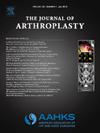胫骨平台骨折转为全膝关节置换术与患者报告的结果不佳、手术时间延长和并发症增加有关。
IF 3.4
2区 医学
Q1 ORTHOPEDICS
引用次数: 0
摘要
背景:胫骨平台骨折(TPF)的开放复位内固定术(ORIF)增加了后续全膝关节置换术(TKA)的复杂性。本研究的目的是比较胫骨平台骨折开放复位内固定术后接受全膝关节置换术的患者与因骨关节炎接受初次全膝关节置换术和无菌翻修全膝关节置换术的患者的治疗效果:2009年1月至2021年6月期间,有52名患者在接受TPF ORIF术后接受了初次TKA,这些患者与208名接受初次TKA的患者按性别、体重指数和美国麻醉医师协会等级以1:4的比例进行了配对。另外还纳入了与 52 名无菌翻修 TKA 患者进行的 1:1 匹配对比。术前和术后 2 年分别进行了膝关节损伤和关节置换骨关节炎结果评分。统计比较采用独立 t 检验和卡方检验:结果:TPF患者的年龄明显小于初治组和翻修组(55 ± 14.0 vs 63 ± 16.3 vs 64 ± 9.5,P < 0.001)。与初治 TKA 患者相比,TPF 组 2 年后的 KOOS JR 评分更低(46.9 ± 18.5 对 66.2 ± 17.8,P = 0.0152),伤口并发症发生率更高(15.4 对 3.9%,P = 0.0020),手术时间更长(140.2 ± 45.3 对 95.2 ± 25.7,P < 0.0001)。TPF组和翻修组在这些指标上没有明显差异。此外,TPF患者需要麻醉下操作(MUA)的可能性高于初次手术和翻修手术患者(21.2%对5.8%对5.8%,P = 0.001):结论:就患者报告的结果、手术时间和伤口并发症而言,TPF 手术后的 TKAs 更像是翻修后的 TKAs 而不是初治 TKAs。MUA发生率高于两个匹配组。这些发现提供了有价值的信息,可以影响这些患者的术前患者教育和术后管理方案。这些研究结果还强调,由于 TKA 的复杂性和并发症增加,有必要将其转换为 TKA。本文章由计算机程序翻译,如有差异,请以英文原文为准。
Conversion of Tibial Plateau Fractures to Total Knee Arthroplasty is Associated With Worse Patient-Reported Outcomes, Increased Operative Times, and Increased Complications
Background
Prior open reduction and internal fixation (ORIF) of tibial plateau fracture (TPF) adds complexity to subsequent total knee arthroplasty (TKA). The purpose of this study was to compare the outcomes of patients undergoing a TKA following prior ORIF of TPF to patients undergoing a primary TKA for osteoarthritis and an aseptic revision TKA.
Methods
There were 52 patients who underwent primary TKA following prior ORIF of TPF between January 2009 and June 2021, who were included and matched in a 1:4 ratio to 208 patients undergoing primary TKA. A second 1:1 matched comparison to 52 aseptic revision TKA patients was also included. The Knee injury and Osteoarthritis Outcome Score for Joint Replacement scores were obtained preoperatively and at two years postoperatively. Independent t-tests and Chi-square tests were used for statistical comparisons.
Results
The TPF patients were significantly younger than both primary and revision cohorts (55 ± 14.0 versus 63 ± 16.3 versus 64 ± 9.5, P < 0.001). Compared to primary TKA patients, the TPF group had worse Knee injury and Osteoarthritis Outcome Score for Joint Replacement scores at two years (46.9 ± 18.5 versus 66.2 ± 17.8, P = 0.0152), higher rates of wound complications (15.4 versus 3.9%, P = 0.0020), and increased operative times (140.2 ± 45.3 versus 95.2 ± 25.7, P < 0.0001). Additionally, TPF patients were more likely to require a manipulation under anesthesia than both primary and revision patients (21.2 versus 5.8 versus 5.8%, P = 0.001).
Conclusions
The TKAs following ORIF of TPF are more like revision TKAs than primary TKAs in terms of patient-reported outcomes, operative times, and wound complications. The rate of manipulation under anesthesia was higher than in both matched groups. These findings provide valuable information that can affect preoperative patient education and postoperative management regimens. They also emphasize the need for a conversion TKA code due to increased complexity and complications seen in this more difficult subset of TKAs.
求助全文
通过发布文献求助,成功后即可免费获取论文全文。
去求助
来源期刊

Journal of Arthroplasty
医学-整形外科
CiteScore
7.00
自引率
20.00%
发文量
734
审稿时长
48 days
期刊介绍:
The Journal of Arthroplasty brings together the clinical and scientific foundations for joint replacement. This peer-reviewed journal publishes original research and manuscripts of the highest quality from all areas relating to joint replacement or the treatment of its complications, including those dealing with clinical series and experience, prosthetic design, biomechanics, biomaterials, metallurgy, biologic response to arthroplasty materials in vivo and in vitro.
 求助内容:
求助内容: 应助结果提醒方式:
应助结果提醒方式:


